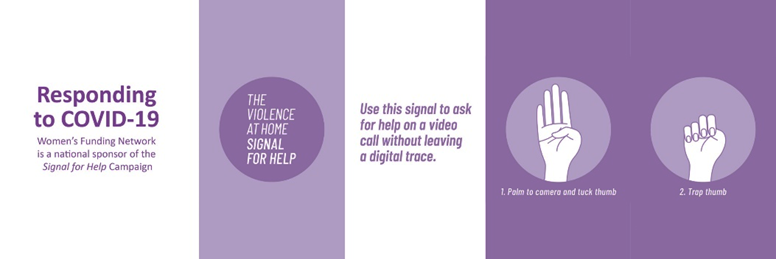Signal for Help Campaign
- Filed under "education"
- Published Monday, May 11, 2020
- « back to articles

As we know, April was Sexual Assault Awareness Month, and 2020 raised concern for potential uptick in incidents of sexual and domestic assault due to home confinement caused by COVID-19.
Living with an abusive partner is challenging enough, and the added stress of the lockdown leaves many victims with escalating situations and nowhere to go. On average, 24 people per minute are victims of rape, physical violence, or stalking by a partner in the U.S. – an estimated 12 million in the course of a year, according to the National Domestic Violence Hotline. Calls for help have skyrocketed: in California, calls to the Fresno sheriff’s office increased by over 70%, and in Texas, there was a 21% increase in calls regarding domestic violence.
Often, calls for help aren’t made, as victims can be threatened by perpetrators and violence can escalate. But the Women’s Funding Network (WFN), an international association of over 100 women’s foundations (Chrysalis has been a member), has launched a new tool for abuse victims to use either online or in person to identify their need for assistance.
#SignalForHelp is a campaign to teach a simple hand gesture for a victim to signal they need help, either online or in person. The signal is simple (pictured left) and involves displaying the palm with the thumb tucked, then closing the fingers to cover the thumb.

This signal is intended to be an alternative to calling 911, and sends a message to anyone watching – family member, friend, co-worker, police – to reach out via text, email, or call to the victim to see if help is needed. It provides a simple gesture for someone to use when feeling threatened.
WFN is promoting this tool throughout its network and beyond, including large-scale companies like Facebook and Salesforce to spread awareness and use of the tool. There is also a toolkit with posters and promotional materials prepared for simple implementation.
IF YOU SEE THE SIGNAL, WFN provides instructions on how to intervene safely with the victim’s wishes in mind. Here are the steps:
1. REACH OUT. Use another form of communication such as text, social media, WhatsApp, or email and ask general questions. This may reduce risk if someone is watching the person’s device or accounts.
2. LISTEN. Ask “yes” or “no” questions. This may reduce risk if someone is listening. For example:
- Can I be a part of your safety plan?”
- “Do you want me to call 911?”(ONLY CALL 911 if the survivor requests it)
- “Would you like me to call a shelter on your behalf?” (Find a shelter in your community by visiting https://www.domesticshelters.org. or contact your local women’s fund or foundation, link at bottom of page.
- “Do you want me to reach out to you regularly?”
- “Should I look for some services that might help you and call you back?”
3. RESPOND. Do what the survivor asks of you. Only call 911 if the survivor asks. Let the survivor tell you what they need, how you can help.
The WFN website provides links to shelters and services as well as a toolkit with across the world, including how to find help if you are in danger. After launching testing a week ago in Canada, there have been positive results in removing women from abusive situations.
A simple yet innovative way to reach out to victims of domestic or sexual abuse, particularly during a time when online work and communication have been increasingly common. Chrysalis is proud to share this resource with our friends and grant partners as another way to build their capacity to help girls and women.